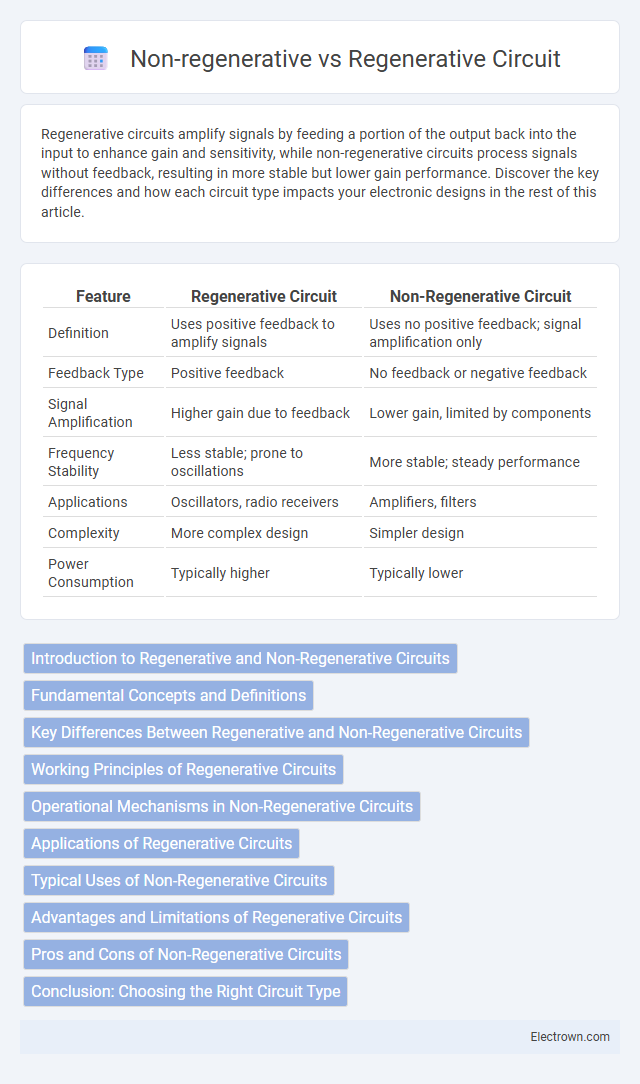Regenerative circuits amplify signals by feeding a portion of the output back into the input to enhance gain and sensitivity, while non-regenerative circuits process signals without feedback, resulting in more stable but lower gain performance. Discover the key differences and how each circuit type impacts your electronic designs in the rest of this article.
Table of Comparison
| Feature | Regenerative Circuit | Non-Regenerative Circuit |
|---|---|---|
| Definition | Uses positive feedback to amplify signals | Uses no positive feedback; signal amplification only |
| Feedback Type | Positive feedback | No feedback or negative feedback |
| Signal Amplification | Higher gain due to feedback | Lower gain, limited by components |
| Frequency Stability | Less stable; prone to oscillations | More stable; steady performance |
| Applications | Oscillators, radio receivers | Amplifiers, filters |
| Complexity | More complex design | Simpler design |
| Power Consumption | Typically higher | Typically lower |
Introduction to Regenerative and Non-Regenerative Circuits
Regenerative circuits use feedback to amplify signals by recycling energy within the system, enhancing gain and stability, while non-regenerative circuits rely solely on direct amplification without feedback loops. The key difference lies in the use of positive feedback in regenerative circuits, which can lead to increased sensitivity and selectivity in applications such as radio receivers. Understanding these principles helps you design or select circuits based on the desired amplification characteristics and stability requirements.
Fundamental Concepts and Definitions
Regenerative circuits utilize feedback to sustain oscillations by continuously amplifying their output signal, whereas non-regenerative circuits lack this feedback loop and rely on external input signals to function. In regenerative circuits, the concept of positive feedback is crucial for maintaining signal energy without additional input, distinguishing them fundamentally from non-regenerative circuits that operate with negative feedback or no feedback at all. Understanding these principles helps you determine the appropriate circuit type for applications requiring signal reinforcement or stable amplification.
Key Differences Between Regenerative and Non-Regenerative Circuits
Regenerative circuits use feedback to amplify signals by feeding a portion of the output back to the input, enhancing gain and selectivity, while non-regenerative circuits do not employ feedback and rely solely on the input signal for amplification. Regenerative circuits are typically found in radio receivers for increased sensitivity, whereas non-regenerative circuits are simpler and used in basic amplification or signal processing tasks. The key difference lies in the presence of positive feedback in regenerative circuits, which significantly boosts signal strength compared to the straightforward amplification in non-regenerative circuits.
Working Principles of Regenerative Circuits
Regenerative circuits operate by feeding a portion of the output signal back to the input, thereby amplifying the signal through positive feedback. This feedback loop increases the circuit's gain without the need for additional power sources, enabling high sensitivity and selectivity. Your design can leverage regenerative principles to enhance signal amplification while minimizing noise in applications like radio receivers and oscillators.
Operational Mechanisms in Non-Regenerative Circuits
Non-regenerative circuits rely on a single-pass signal amplification without feedback, causing the output signal to be directly proportional to the input signal amplitude. The operational mechanism involves amplification through active devices like transistors or amplifiers, where the input signal is processed once and sent to the output, often resulting in lower gain and selectivity. These circuits are simpler but less efficient than regenerative circuits, which use positive feedback to enhance signal strength and sensitivity.
Applications of Regenerative Circuits
Regenerative circuits are widely used in applications such as radio receivers and signal amplification, where they enhance sensitivity and selectivity by feeding a portion of the output signal back into the input. These circuits are essential in oscillators, providing controlled feedback to sustain oscillations at desired frequencies. Their ability to amplify weak signals with low power consumption makes them ideal for early-stage amplification in communication devices and sensor interfaces.
Typical Uses of Non-Regenerative Circuits
Non-regenerative circuits are typically used in applications requiring stable, linear amplification such as audio amplifiers, buffering stages, and signal processing where feedback is minimized to prevent oscillations. These circuits excel in maintaining signal fidelity without the enhanced gain found in regenerative designs, making them ideal for moderate amplification tasks and impedance matching in communication systems. Your choice of a non-regenerative circuit ensures reliable performance in environments where stability and linearity are critical for accurate signal transmission.
Advantages and Limitations of Regenerative Circuits
Regenerative circuits offer significant advantages, including high gain and reduced power consumption, making them ideal for sensitive signal detection in radio frequency applications. Their key limitation lies in potential instability and increased noise due to feedback loops, which can affect signal fidelity and circuit performance. Understanding these trade-offs helps you optimize circuit design for specific uses by balancing sensitivity against noise and stability concerns.
Pros and Cons of Non-Regenerative Circuits
Non-regenerative circuits offer simplicity and fast response times, making them ideal for applications requiring quick signal amplification without feedback complexities. However, their lack of feedback results in lower gain stability and reduced selectivity compared to regenerative circuits. Your choice depends on whether you prioritize design simplicity or enhanced performance features like sensitivity and signal clarity.
Conclusion: Choosing the Right Circuit Type
Selecting between regenerative and non-regenerative circuits depends on application requirements such as efficiency, complexity, and power handling. Regenerative circuits offer enhanced signal amplification and energy efficiency, ideal for low-power and precision electronics, while non-regenerative circuits provide simpler design and stability suitable for high-power or broadband applications. Evaluate factors like gain, noise, and feedback needs to determine the optimal circuit type for specific electronic systems.
Regenerative vs non-regenerative circuit Infographic

 electrown.com
electrown.com